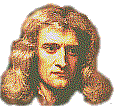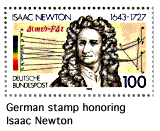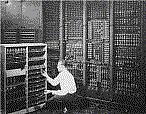


 |

 Newton's Principia inspired scientific theory and discoveries for the next 200 years. The existence and location of new planet was predicted from Newton's law. In the 1820's astronomers had enough accurate data on the motion of the planet Uranus to notice that Uranus did not move according to predictions calculated from Newton's law. John Couch Adams, a student at Cambridge, had the bright idea that Uranus was following Newton's law but in response to the force from all the known planets as well as in response to the force from yet another planet which astronomers had not observed yet. He calculated where the astronomers should look for the new planet. The subsequent search involved astronomers in England, France and Germany and the planet was finally observed, with all the countries claiming credit.
Newton's Principia inspired scientific theory and discoveries for the next 200 years. The existence and location of new planet was predicted from Newton's law. In the 1820's astronomers had enough accurate data on the motion of the planet Uranus to notice that Uranus did not move according to predictions calculated from Newton's law. John Couch Adams, a student at Cambridge, had the bright idea that Uranus was following Newton's law but in response to the force from all the known planets as well as in response to the force from yet another planet which astronomers had not observed yet. He calculated where the astronomers should look for the new planet. The subsequent search involved astronomers in England, France and Germany and the planet was finally observed, with all the countries claiming credit.
The prediction and discovery of Neptune is a typical example of what constitutes progress in science. We believe scientific explanations if they predict fact we don't know yet. A story that only explains what we already know is pretty worthless. Anybody with a good imagination can do that. To predict a new, reproducible observation is what we look for in a
scientific theory.
 The Egyptians developed early
geometry to deal with the flooding of the Nile river which required yearly recalculations and remarkings of the land areas.
The formulation of the laws of physics by Isaac Newton in terms of mathematical relations and the subsequent application of these laws to celestial mechanics led to the development of calculus .
The Egyptians developed early
geometry to deal with the flooding of the Nile river which required yearly recalculations and remarkings of the land areas.
The formulation of the laws of physics by Isaac Newton in terms of mathematical relations and the subsequent application of these laws to celestial mechanics led to the development of calculus .
The newly acquired understanding of physical phenomena spawned the engineering efforts of the industrial revolution. These led to the development of the mathematics of differential equations.

The synthesis of physics of electricity and magnetism by
James Clark Maxwell
gave birth to the mathematics of vector calculus. The new mathematics revealed the connection between electricity and magnetism and light and led to the discovery of electromagnetic waves. The engineering applications of these ideas gave us modern radio and TV.
The new understanding of the connection between electricity, magnetism and light gave birth to quantum physics. Quantum physics generated a host of new mathematical ideas, among them functional analysis and group theory . A substantial part of the new quantum mathematics was generated by John Von Neumann who is also credited to be the father of the modern computer.
This physics-mathematics-engineering-physics cycle is alive and well today and it continues to chase the frontier of our understanding of nature.
 One of the earliest known computing devices is the abacus, invented about 2000 years ago and still in use today.
One of the earliest known computing devices is the abacus, invented about 2000 years ago and still in use today.
Skipping the slide rule and other analog devices, we credit Blaise Pascal with the invention of the first digital computer in 1642 to help his father who was a tax collector.
Between 1812 and 1833, Charles Babbage in Cambridge, England build several versions of his Analytical Machine which is the forerunner of the modern computer.
Between 1850 and 1900 many computing devices were built to accommodate the practical needs of people building railroads, bridges and textile mills.
At about the same time the mathematician John Von Neumann
developed the theoretical basis for modern computing. He proposed that the same devices can be used to perform many different computations if it contains a PROGRAM. A series of instructions that tell it what to do with the data. As new computational needs arise, the devices is give a new program. Notice that this is different from building the procedure into the device itself. The ultimate extension of this idea are smart programmable devices which we are beginning to see today. The computing heart of these devices is the integrated circuit called a chip. A modern chip holds the equivalent of several ENIAC's on a tiny wafer, smaller than the palm of a child's hand. In recent years computers have penetrated into most human activities.
 The advent of vacuum tubes led to the building of the first electronic computer, the ENIAC, in 1946.
The advent of vacuum tubes led to the building of the first electronic computer, the ENIAC, in 1946.
For extra credit answer the following questions. 1. Isaac Newton is known for at least three major accomplishments in addition to the laws of Mechanics. What are they?
1. Isaac Newton is known for at least three major accomplishments in addition to the laws of Mechanics. What are they?
 2. What is the current status of Newton's Theory of Motion? Is it still a valid theory?
2. What is the current status of Newton's Theory of Motion? Is it still a valid theory?
 3. What is vector calculus?
3. What is vector calculus?